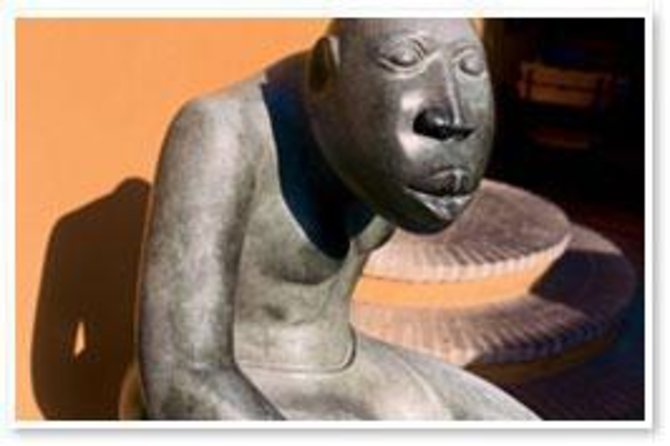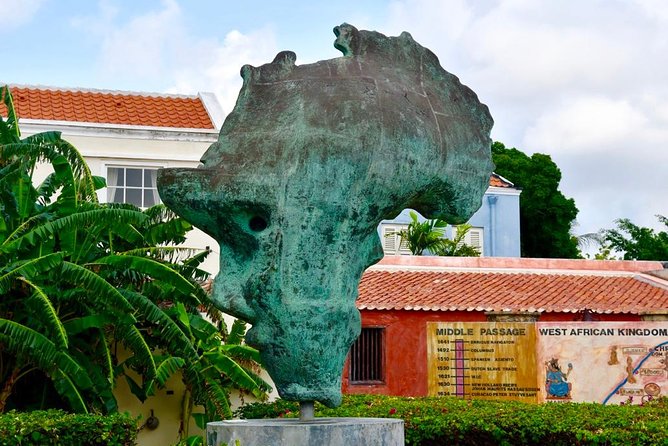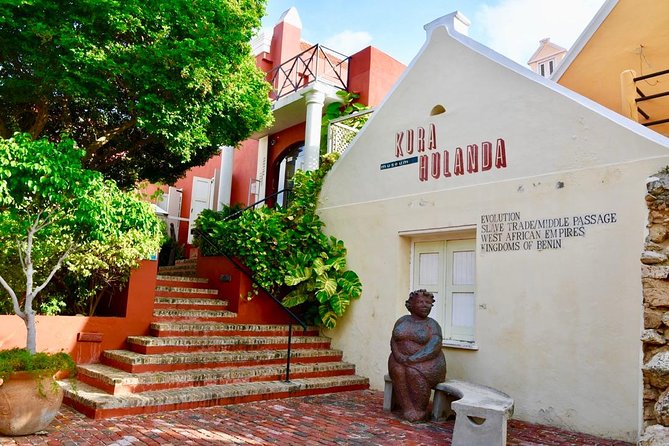Unraveling the harrowing past of the Transatlantic Slave Trade, the Museum Kura Hulanda in Curacao offers a profoundly educational journey. With a skip-the-line admission ticket, visitors can explore the museum’s meticulously curated collection of artifacts and exhibits, which vividly chronicle the experiences of millions of Africans forcibly relocated to the New World. As they explore the lasting impact and cultural influences of this complex history, guests are sure to emerge with a deeper understanding of this pivotal chapter in human history. But the true power of the museum lies in its ability to move and inspire, leaving a lasting impression on all who venture through its halls.
Key Points

- Save time by pre-booking your admission ticket to skip the lines at the Museum Kura Hulanda.
- Explore the museum’s extensive collection of artifacts and exhibits chronicling the Transatlantic Slave Trade at your own pace.
- Benefit from the museum’s convenient operating hours, with the facility open from Monday to Sunday.
- Enhance your experience with an optional guided tour in Dutch or English for an additional fee.
- Enjoy the museum’s wheelchair-friendly accessibility and on-site parking options for a hassle-free visit.
Overview of Museum Kura Hulanda

The Museum Kura Hulanda powerfully chronicles the harrowing history and enduring legacy of the Transatlantic Slave Trade, transporting visitors through a meticulously curated collection of artifacts and exhibits that vividly depict the experiences of millions of Africans forcibly relocated to the New World over the course of four centuries.
Situated in the charming harbor town of Willemstad, Curacao, the museum offers a profoundly moving and educational journey, tracing the profound cultural influences and lasting impacts of this devastating chapter in human history.
Through its thoughtful curation and immersive exhibits, the Museum Kura Hulanda stands as a powerful testament to the resilience and dignity of the African diaspora, and a vital resource for understanding and honoring this complex and painful past.
You can also read our reviews of more tours and experiences in Willemstad.
Transatlantic Slave Trade History

Between the 16th and 19th centuries, millions of Africans endured the harrowing experience of forced relocation and sale in the New World, as the Transatlantic Slave Trade irrevocably reshaped the lives and cultures of both continents. This dark chapter in human history uprooted families, erased cultural identities, and subjected Africans to unimaginable cruelty.
The Museum Kura Hulanda’s exhibits paint a vivid and sobering portrait of this complex legacy:
- Authentic artifacts and personal accounts illustrate the dehumanizing conditions of the slave trade.
- Displays explore the lasting impact on Caribbean societies and the struggle for freedom and autonomy.
- Interactive elements encourage visitors to reflect on the moral and ethical implications of this history.
- Thoughtful curation fosters a deeper understanding of the Transatlantic Slave Trade’s profound and lasting consequences.
African Artifacts and Influences
While visitors explore the exhibits at Museum Kura Hulanda, they’ll discover a remarkable collection of artifacts that showcase the rich cultural heritage and enduring influence of continental Africa on the history and identity of Curacao and the broader Caribbean region.
From intricate textiles and carved wooden sculptures to ceremonial masks and ornate jewelry, the museum’s African collection offers a captivating glimpse into the artistic traditions and spiritual practices that have been woven into the cultural fabric of the Caribbean.
Visitors can marvel at the striking similarities between the artifacts on display and the vibrant artwork, music, and customs that still thrive in Curacao and neighboring islands, underscoring the profound and lasting impact of Africa’s diaspora.
Museum Location and Hours
Located in the heart of Willemstad’s historic harbor, Museum Kura Hulanda welcomes visitors Monday through Saturday from 8:00am to 4:00pm, and on Sundays from 9:00am to 2:00pm.
The museum remains closed on official holidays, allowing guests to fully enjoy the captivating exhibits without disruption.
The museum’s convenient location makes it easily accessible for travelers. Visitors can explore the museum’s vast collection of artifacts and learn about the profound impact of the Transatlantic Slave Trade at their own pace.
Whether you’re a history buff or simply curious about Curacao’s rich cultural heritage, Museum Kura Hulanda offers an enlightening and thought-provoking experience.
Features:
- Guided tours available in Dutch and English for $3 per person
- Wheelchair and stroller accessible
- Near public transportation
- Free cancellation up to 24 hours before experience starts
Guided Tour Details
Visitors to Museum Kura Hulanda can enhance their experience with a guided tour, offered in both Dutch and English for an additional $3 per person.
These tours provide valuable insights and context, allowing guests to delve deeper into the museum’s extensive collection of artifacts and learn about the profound impacts of the Transatlantic Slave Trade.
The knowledgeable guides bring the museum’s exhibits to life, sharing compelling stories and historical anecdotes that give visitors a richer understanding of this complex and impactful period of history.
- Curacao: Swimming With Sea Turtles and Grote Knip Beach Tour
- Curacao Highlights Scenic, History and Cultural Tour
- Curacao Sea Turtle Swim and West Side Natural Highlights
- Private Discover Scuba Dive Experience in Curaçao
- Full-Day Private Tour of East and West Curacao Island
- Authentic Curacao : Private Full Island Tour
Included in Admission Ticket
Purchasing a Museum Kura Hulanda admission ticket grants visitors access to a wealth of historical artifacts and exhibits that chronicle the profound impacts of the Transatlantic Slave Trade.
Upon entry, guests are greeted by a knowledgeable receptionist who provides them with a detailed map, guiding them through the museum’s carefully curated collections.
Plus, visitors may browse the on-site museum shop, perusing a selection of themed souvenirs and keepsakes to commemorate their educational and thought-provoking experience.
The admission ticket includes:
- Access to the museum’s expansive galleries and displays
- Assistance from the friendly receptionist staff
- A comprehensive museum map to navigate the exhibits
- Opportunity to purchase souvenirs from the on-site shop
Accessibility and Transportation
The museum ensures accessibility for all visitors, with its wheelchair-friendly surfaces and transportation options available nearby. Guests can easily navigate the exhibits using the museum’s stroller-accessible layout, and public transit connections in the surrounding harbor area provide convenient access to the site.
| Accessibility Features | Level of Accessibility | Convenience |
|---|---|---|
| Wheelchair Access | Fully Accessible | Excellent |
| Stroller Accessibility | Fully Accessible | Excellent |
| Public Transportation | Nearby Connections | Convenient |
| Parking | Limited On-Site | Moderate |
| Signage | Clear and Informative | Excellent |
The museum’s commitment to inclusive design and accessibility ensures that visitors of all abilities can fully enjoy the powerful history and cultural insights shared within its exhibits.
Booking and Cancellation Policy
As visitors plan their trip, they’ll find that the Museum Kura Hulanda offers a straightforward booking process, with confirmation provided at the time of reservation.
On top of that, the museum’s generous cancellation policy allows for free cancellation up to 24 hours before the scheduled experience, granting guests the flexibility to adjust their plans as needed.
Key details about booking and cancellation include:
- Confirmation received immediately upon booking
- Maximum group size of 15 travelers per tour/activity
- Free cancellation up to 24 hours prior to experience start
- Convenient for last-minute changes or unexpected schedule conflicts
With these hassle-free booking and cancellation policies, visitors can confidently secure their spot at the captivating Museum Kura Hulanda and focus on seeing the powerful story it has to share.
Frequently Asked Questions
Can I Take Photos Inside the Museum?
Visitors are welcome to take photos inside the Museum Kura Hulanda. However, they’re asked to be respectful and avoid using flash, as it could disturb the museum’s atmosphere and artifacts. Photography policies are in place to preserve the museum’s collection and enhance the visitor experience.
Is Food and Drink Allowed Inside the Museum?
Visitors are not permitted to bring food or drinks inside the Museum Kura Hulanda. This rule helps preserve the museum’s artifacts and maintains a reverent atmosphere for learning about the somber history of the Transatlantic Slave Trade.
Are There Lockers or Storage Available On-Site?
The museum doesn’t offer lockers or storage for visitors. However, guests can leave personal belongings at the reception desk while they explore the exhibits. This allows them to fully enjoy the museum’s powerful historical displays.
What Is the Dress Code for Visiting the Museum?
The museum has a casual, relaxed dress code. Visitors can wear comfortable clothing and footwear, as they’ll be exploring the exhibits and walking through the space. There’s no need for formal attire when visiting Museum Kura Hulanda.
Can I Purchase Additional Souvenirs Beyond the Museum Shop?
Visitors can indeed purchase additional souvenirs beyond the museum shop, as the surrounding historic Willemstad district offers a variety of local boutiques, craft markets, and artisan shops selling unique Curaçaoan handicrafts, jewelry, and other cultural keepsakes.
Recap
The Museum Kura Hulanda offers a powerful and unforgettable experience, meticulously chronicling the harrowing history of the Transatlantic Slave Trade.
Visitors can enjoy the museum’s captivating collection of artifacts, which vividly depict the tragic experiences of millions and their lasting cultural influences.
It’s a vital resource for understanding this chapter in human history, providing a profoundly moving and educational journey through a complex and painful past.
More Tour Reviews in Willemstad
Not for you? Here's more things to do in Willemstad we have recnetly reviewed
- East to West Island Tour Experience
- TUGBOAT Snorkeling Trip
- Snorkel With Turtles & Kenepa Grandi Beach: Nr.1 Island Day Trip
- Discover Scuba Diving
- Curaçao History, Kunuku and Beach Tour
- City Highlights & Cave
- 3-hour Roundtrip East Side Of Curacao
- Curacao Private Tour and Activity Experience (4 up to 13 People)
- Curaçao Island Tour
- Western Snorkel & Swim Trip
- Breath of Curacao Safari
- Vibrant City Tour by Night: the Perfect Night Out When in Curacao
